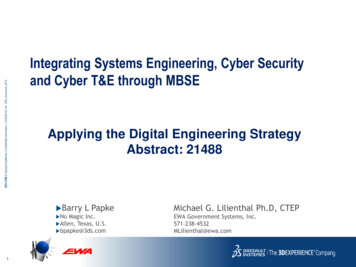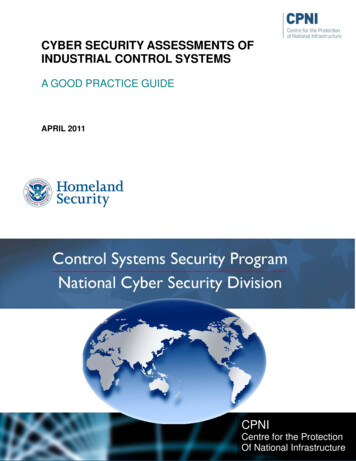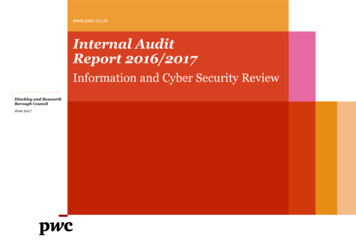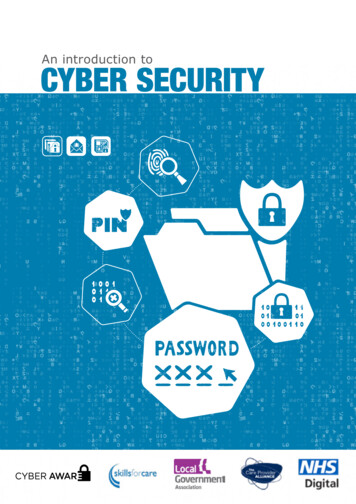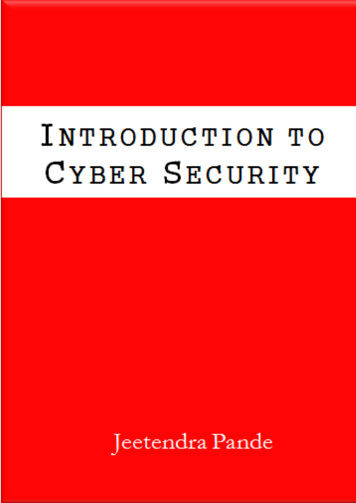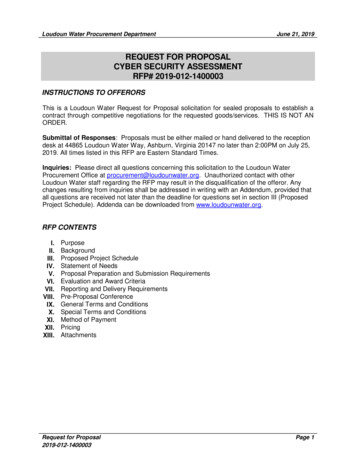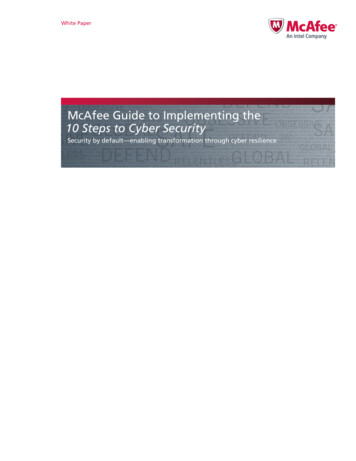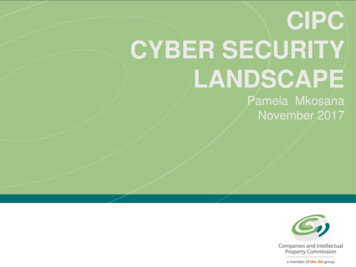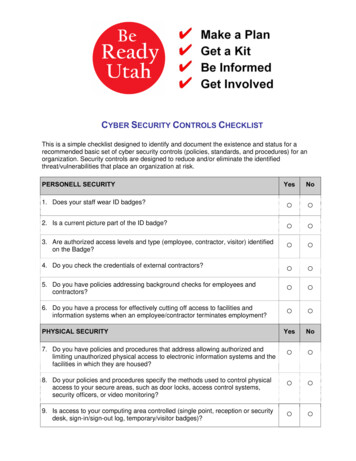
Transcription
CYBER SECURITY CONTROLS CHECKLISTThis is a simple checklist designed to identify and document the existence and status for arecommended basic set of cyber security controls (policies, standards, and procedures) for anorganization. Security controls are designed to reduce and/or eliminate the identifiedthreat/vulnerabilities that place an organization at risk.PERSONELL SECURITYYesNo1. Does your staff wear ID badges? 2. Is a current picture part of the ID badge? 3. Are authorized access levels and type (employee, contractor, visitor) identifiedon the Badge? 4. Do you check the credentials of external contractors? 5. Do you have policies addressing background checks for employees andcontractors? 6. Do you have a process for effectively cutting off access to facilities andinformation systems when an employee/contractor terminates employment? YesNo7. Do you have policies and procedures that address allowing authorized andlimiting unauthorized physical access to electronic information systems and thefacilities in which they are housed? 8. Do your policies and procedures specify the methods used to control physicalaccess to your secure areas, such as door locks, access control systems,security officers, or video monitoring? 9. Is access to your computing area controlled (single point, reception or securitydesk, sign-in/sign-out log, temporary/visitor badges)? PHYSICAL SECURITY
10. Are visitors escorted into and out of controlled areas? 11. Are your PCs inaccessible to unauthorized users (e.g. located away from publicareas)? 12. Is your computing area and equipment physically secured? 13. Are there procedures in place to prevent computers from being left in a loggedon state, however briefly? 14. Are screens automatically locked after 10 minutes idle? 15. Are modems set to Auto-Answer OFF (not to accept incoming calls)? 16. Do you have procedures for protecting data during equipment repairs? 17. Do you have policies covering laptop security (e.g. cable lock or securestorage)? 18. Do you have an emergency evacuation plan and is it current? 19. Does your plan identify areas and facilities that need to be sealed offimmediately in case of an emergency? 20. Are key personnel aware of which areas and facilities need to be sealed off andhow? YesNo21. Do you have policies and standards covering electronic authentication,authorization, and access control of personnel and resources to yourinformation systems, applications and data? 22. Do you ensure that only authorized personnel have access to your computers? 23. Do you require and enforce appropriate passwords? 24. Are your passwords secure (not easy to guess, regularly changed, no use oftemporary or default passwords)? 25. Are you computers set up so others cannot view staff entering passwords? YesNo ACCOUNT AND PASSWORD MANAGEMENTCONFIDENTIALITY OF SENSITIVE DATA26. Do you classify your data, identifying sensitive data versus non sensitive?
27. Are you exercising responsibilities to protect sensitive data under your control? 28. Is the most valuable or sensitive data encrypted? 29. Do you have a policy for identifying the retention of information (both hard andsoft copies)? 30. Do you have procedures in place to deal with credit card information? 31. Do you have procedures covering the management of personal privateinformation? 32. Is there a process for creating retrievable back up and archival copies of criticalinformation? 33. Do you have procedures for disposing of waste material? 34. Is waste paper binned or shredded? 35. Is your shred bin locked at all times? 36. Do your policies for disposing of old computer equipment protect against lossof data (e.g. by reading old disks and hard drives)? 37. Do your disposal procedures identify appropriate technologies and methods formaking hardware and electronic media unusable and inaccessible (such asshredding CDs and DVDs, electronically wiping drives, burning tapes) etc.)? YesNo38. Do you have a current business continuity plan? 39. Is there a process for creating retrievable back up and archival copies of criticalinformation? 40. Do you have an emergency/incident management communications plan? 41. Do you have a procedure for notifying authorities in the case of a disaster orsecurity incident? 42. Does your procedure identify who should be contacted, including contactinformation? 43. Is the contact information sorted and identified by incident type? 44. Does your procedure identify who should make the contacts? DISASTER RECOVERY
45. Have you identified who will speak to the press/public in the case of anemergency or an incident? 46. Does your communications plan cover internal communications with youremployees and their families? 47. Can emergency procedures be appropriately implemented, as needed, bythose responsible? YesNo48. Are you providing information about computer security to your staff? 49. Do you provide training on a regular recurring basis? 50. Are employees taught to be alert to possible security breaches? 51. Are your employees taught about keeping their passwords secure? 52. Are your employees able to identify and protect classified data, including paperdocuments, removable media, and electronic documents? 53. Does your awareness and education plan teach proper methods for managingcredit card data (PCI standards) and personal private information (Socialsecurity numbers, names, addresses, phone numbers, etc.)? COMPLIANCE AND AUDITYesNo54. Do you review and revise your security documents, such as: policies,standards, procedures, and guidelines, on a regular basis? 55. Do you audit your processes and procedures for compliance with establishedpolicies and standards? 56. Do you test your disaster plans on a regular basis? 57. Does management regularly review lists of individuals with physical access tosensitive facilities or electronic access to information systems? SECURITY AWARENESS AND EDUCATIONChecklist Response AnalysisFor each question that is marked “No,” carefully review its applicability to your organization.Implementing or improving controls decreases potential exposure to threats/vulnerabilities that mayseriously impact the ability to successfully operate.
CYBER SECURITY THREAT/VULNERABILITY ASSESSMENTA threat is the potential for a person or a thing to exercise (accidentally trigger or intentionallyexploit) a flaw or weaknesses (vulnerability) within an organization. There are several types ofthreats that my occur within an information system or operating environment Threats are usuallygrouped into general categories such as natural, human, and environmental, for example:NATURAL THREATSStorm damage (e.g.,flood)FireLightning strikesTornadoHUMAN THREATSComputer abuseUnauthorized access to PrivacyAct and proprietary informationTerrorismSabotage or vandalismSystem tamperingSpoofingFraudImpersonation and socialengineeringHackingNegligence or humanerrorTheftFalsified dataENVIRONMENTAL THREATSLong-term power failureChemical leakagePollutionThe desired outcome of identifying and reviewing (assessing) threats and vulnerabilities isdetermining potential and actual risks to the organization. Risk is a combination of factors orevents (threats and vulnerabilities) that, if they occur, may have an adverse impact on theorganizations. Risk is established by considering the potential impact and likelihood of avulnerability being exploited by a threat. Risk only exists when threats have the capability oftriggering or exploiting vulnerabilities. The following formula is used to determine a risk score:Risk Impact x LikelihoodFor this assessment, numeric rating scales are used to establish impact potential (0-6) andlikelihood probability (0-5).IMPACT SCALELIKELIHOOD SCALE1. Impact is negligible0. Unlikely to occur2. Effect is minor, major agency operations arenot affected1. Likely to occur less than once per year3. Organization operations are unavailable for a 2. Likely to occur once per yearcertain amount of time, costs are incurred.Public/customer confidence is minimallyaffected4. Significant loss of operations, significantimpact on pubic/customer confidence3. Likely to occur once per month
IMPACT SCALELIKELIHOOD SCALE5. Effect is disastrous, systems are down for anextended period of time, systems need to berebuilt and data replaced4. Likely to occur once per week6. Effect is catastrophic, critical systems are5. Likely to occur dailyoffline for an extended period; data are lost orirreparably corrupted; public health and safetyare affectedWhen determining impact, consider the value of the resources at risk, both in terms of inherent(replacement) value and the importance of the resources (criticality) to the organization’ssuccessful operation.Factors influencing likelihood include: threat capability, frequency of threat occurrence, andeffectiveness of current countermeasures (security controls). Threats caused by humans arecapable of significantly impairing the ability for an organization to operate effectively. Humanthreats sources include:SOURCESOURCE DESCRIPTIONInsiders:Employees, owners, stock holders, etc.General contractors andsubcontractorsCleaning crew, developers, technical support personnel, andcomputer and telephone service repair crewFormer employees:Employees who have retired, resigned, or were terminatedUnauthorized users:Computer criminals, terrorists, and intruders (hackers andcrackers) who attempt to access agency/enterprise resources.Finally, use the following table to determine and understand the potential criticality (risk level) ofeach threat/vulnerability based on the calculated risk value.SCORERISK LEVELRISK OCCURRENCE RESULT21-30High RiskOccurrence may result in significant loss of major tangible assets,information, or information resources. May significantly disrupt theorganization’s operations or seriously harm its reputation.11-20Medium RiskOccurrence may result in some loss of tangible assets, information,or information resources. May disrupt or harm the organization’soperation or reputation. For example, authorized users aren’t able toaccess supportive data for several days.1-10Low RiskOccurrence may result in minimal loss of tangible assets, information,or information resources. May adversely affect the organization’soperation or reputation. For example, authorized users aren’t grantedaccess to supportive data for an hour.
CYBER SECURITY THREAT/VULNERABILITY ASSESSMENTHUMAN THREATSImpact(0-6)Probability(0-5)Score(Impact xProbability)1. Human Error Accidental destruction, modification, disclosure, orincorrect classification of informationFFF Ignorance: inadequate security awareness, lack ofsecurity guidelines, lack of proper documentation,lack of knowledgeFFF Workload: Too many or too few systemadministrators, highly pressured usersFFF Users may inadvertently give information onsecurity weaknesses to attackersFFF Incorrect system configurationFFF Security policy not adequateFFF Security policy not enforcedFFF Security analysis may have omitted somethingimportant or be wrong.FFFFFF2. Dishonesty: Fraud, theft, embezzlement, selling ofconfidential agency information3. Attacks by “social engineering” Attackers may use telephone to impersonateemployees to persuade users/administrators togive user name/passwords/modem numbers, etc.FFF Attackers may persuade users to execute TrojanHorse act xProbability)1. Unauthorized use of “open” computers/Laptops’FFF2. Mixing of test and production data or environmentsFFF3. Introduction of unauthorized software or hardwareFFF4. Abuse of privileges/trustGENERAL THREATS
4. Time bombs: Software programmed to damage asystem on a certain date5. Operating system design errors: Certain systems werenot designed to be highly secureFFF6. Protocol design errors: Certain protocols were notdesigned to be highly secure. Protocol weaknesses inTCP/IP can result in: Source routing, DNS spoofing, TCP sequenceguessing, unauthorized accessFFF Hijacked sessions and authenticationsession/transaction replay, data is changed orcopied during transmissionFFF Denial of service, due to ICMP bombing, TCP-SYNflooding, large PING packets, etc.FFF7. Logic bomb: Software programmed to damage asystem under certain conditionsFFF8. Viruses in programs, documents, e-mail act xProbability)1. Attack programs masquerading as normal programs(Trojan horses).FFF2. Attack hardware masquerading as normal commercialhardwareFFF3. External attackers masquerading as valid users orcustomersFFF4. Internal attackers masquerading as valid users orcustomersFFF5. Attackers masquerading as (0-5)Score(Impact xProbability)IDENTIFICATION AUTHORIZATION THREATSPRIVACY THREATS1. Eavesdropping Electromagnetic eavesdropping / Ban Eck radiationFFF Telephone/fax eavesdropping (via “clip-on”telephone bugs, inductive sensors, or hacking thepublic telephone exchangesFFF Network eavesdropping. Unauthorized monitoringof sensitive data crossing the internal network,unknown to the data ownerFFF Subversion of ONS to redirect email or other trafficFFF
Subversion of routing protocols to redirect email orother trafficFFF Radio signal eavesdropping,FFF Rubbish eavesdropping (analyzing waste forconfidential documents, etc.)FFFImpact(0-6)Probability(0-5)Score(Impact xProbability)1. Malicious, deliberate damage of information orinformation processing functions from external sourcesFFF2. Malicious, deliberate damage of information orinformation processing functions from internal sourcesFFF3. Deliberate modification of act xProbability)1. Password cracking (access to password files, use ofbad – blank, default, rarely changed – passwords)FFF2. External access to password files, and sniffing of thenetworksFFF3. Attack programs allowing external access to systems(back doors visible to external networks)FFF4. Attack programs allowing internal access to systems(back doors visible to internal networks)FFF5. Unsecured maintenance modes, developer backdoorsFFF6. Modems easily connected, allowing uncontrollableextension of the internal networkFFF7. Bugs in network soft are which can openunknown/unexpected security holes (holes can beexploited from external networks to gain access. Thisthreat grows as software becomes increasinglycomplex)FFF8. Unauthorized physical access to systemFFFImpact(0-6)Probability(0-5)Score(Impact xProbability)FFFINTEGRITY / ACCURACY THREATSACCESS CONTROL THREATSREPUDIATION THREAT1. Receivers of confidential information may refuse toacknowledge receipt2. Senders of confidential information may refuse toacknowledge source
LEGAL THREATSImpact(0-6)Probability(0-5)Score(Impact xProbability)1. Failure to comply with regulatory or legal requirements(ie, to protect confidentiality of employee data)FFF2. Liability for acts of internal users or attackers whoabuse the system to perpetrate unlawful acts (ie,incitement to racism, gambling, money laundering,distribution of pornographic or violent material)FFF3. Liability for damages if an internal user attacks act xProbability)1. Major natural disasters, fire, smoke, water, earthquake,storms/hurricanes/tornadoes, power outages, etcFFF2. Minor natural disasters, of short duration, or causinglittle damageFFF3. Major human-caused disasters: war, terrorist incidents,bombs, civil disturbance, dangerous chemicals,radiological accidents, etc.FFF4. Equipment failure from defective hardware, cabling, orcommunications system.FFF5. Equipment failure from airborne dust, electromagneticinterference, or static electricityFFFRELIABILITY OF SERVICE THREATS6. Denial of Service: Network abuse: Misuse of routing protocols toconfuse and mislead systemsFFF Server overloading (processes, swap space,memory, “tmp” directories, overloading services)FFF Email bombingFFF Downloading or receipt of malicious Applets, ActiveX controls, macros, PostScript files, etcFFF7. Sabotage: Malicious, deliberate damage of informationor information processing functions. Physical destruction of network interface devices,cablesFFF Physical destruction of computing devices ormediaFFF Destruction of electronic devices and media byelectromagnetic radiation weapons (HERF Gun,EMP/T Gun)FFF
Deliberate electrical overloads or shutting offelectrical powerFFF Viruses and/or worms. Deletion of critical systemsfilesFFFNext StepsAfter completing a review of current security controls and along with a review and rating ofpotential threats/vulnerabilities, a series of actions should be determined to reduce risk (threatsexploiting vulnerabilities) to and acceptable level. These actions should include putting into placemissing security controls, and/or increasing the strength of existing controls.Security controls should ideally reduce and/or eliminate vulnerabilities and meet the needs of thebusiness. Cost must be balanced against expected security benefit and risk reduction. Typically,security remediation efforts and actions will be focused on addressing identified high riskthreat/vulnerabilitiesThe following table identifies a set of remediation activities designed to focus on the commonlyidentified High risk threats and vulnerabilities. Actions are ranked in priority order of effectiveness.Example Recommended Security Risk Remediation ActionsNo.Remediation ActionCostBenefitRisk1Develop a foundation of Security Policies,Practices and Procedures, especially in thearea of Change ControlLowHighHigh2Establish and enforce a globally-acceptedpassword policyLowHighHigh3Address vulnerability results in order of highrisk to low riskLowHighHigh4Establish an Operations group facilitateddiscussion to improve processes andcommunications, and to eliminate anymisunderstandingsLowHighHigh5Establish router configuration securitystandards, forming baseline practicesLowHighHigh6Harden servers on the internal networkLowHighHighNo.Remediation ActionCostBenefitRisk7More closely integrate worker terminationactivities between HR and IT. Incorporate newhire orientation and annual security “refresher”for all employees.Low toModerateHighHigh
No.Remediation ActionCostBenefitRisk8Redesign the internet perimeter, incorporatingconcepts of N-tier architecture and “defense indepth” into the redesign of the Internetperimeter and Enterprise ArchitectureLow toModerateHighHigh9Migrate to a more centralized and integratedmodel of operations management, includingcentralized logging, event correlation, andalertingLow toModerateHighHigh10Complete the intrusion detection infrastructureModerateHighHigh11Install encryption on mobile computers toprotect the confidentiality and integrity of data.Moderate toExpensiveHighHigh12Perform data classification to determinesecurity levels to protect that dataModerate toExpensiveHighHigh13Institute vulnerability scanning as a regularscheduled maintenance taskModerate toExpensiveHighHigh14Reclassify email as a mission criticalapplicationLowModerateMedium15Complete security staffing for the ISO SecurityGroupExpensiveHighHigh16Complete Computer Security IncidentResponse Team (CSIRT) capabilityModerate toExpensiveHighHigh
This is a simple checklist designed to identify and document the existence and status for a recommended basic set of cyber security controls (policies, standards, and procedures) for an organization. Security controls are designed to reduce and/or eliminate the identified threat/vulnerabilities that place an organization at risk.

